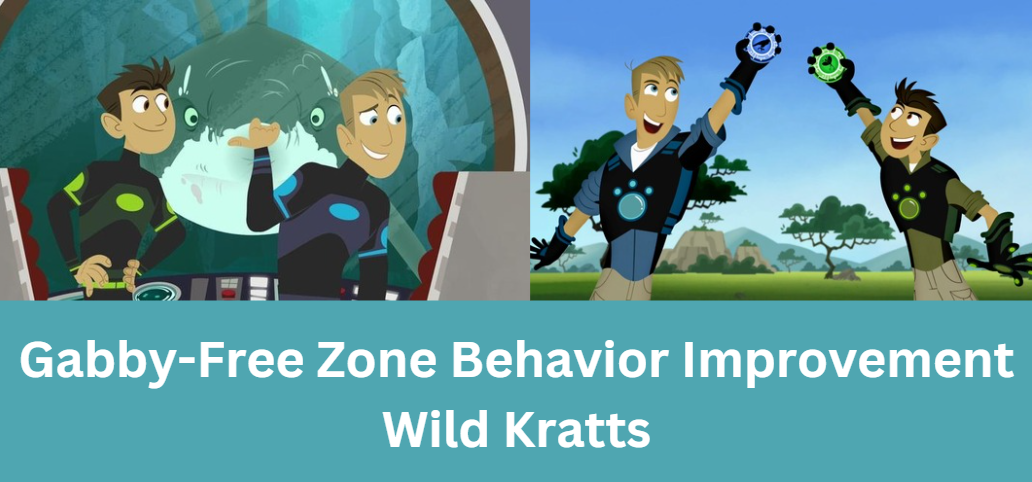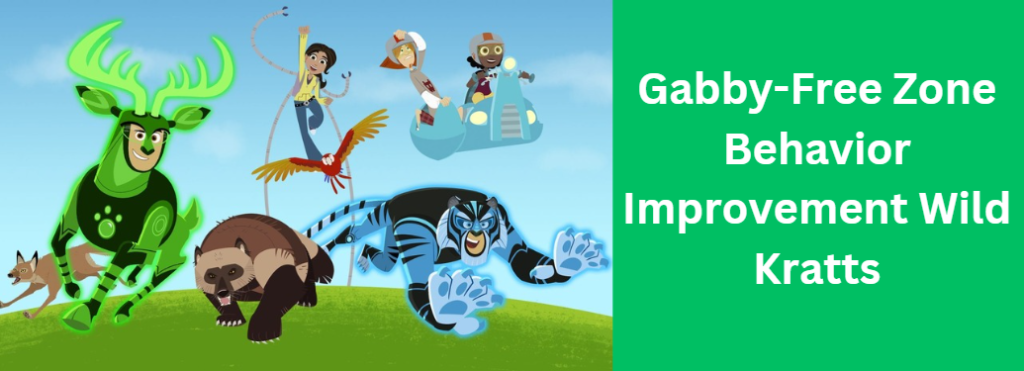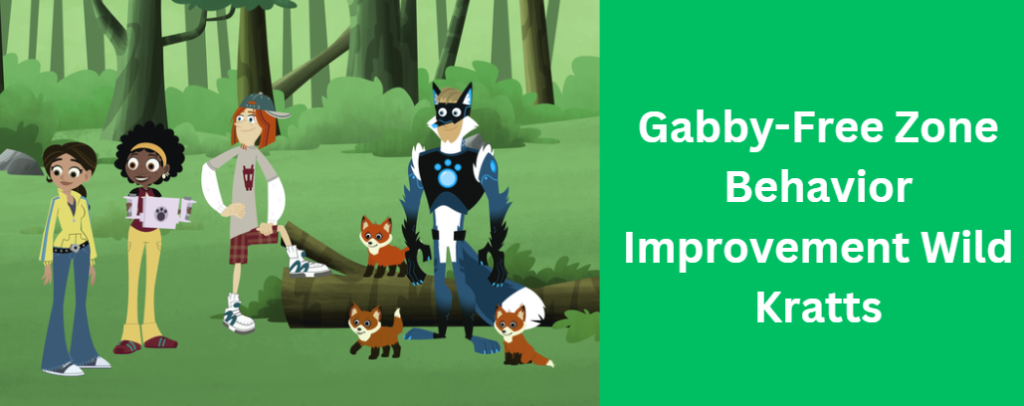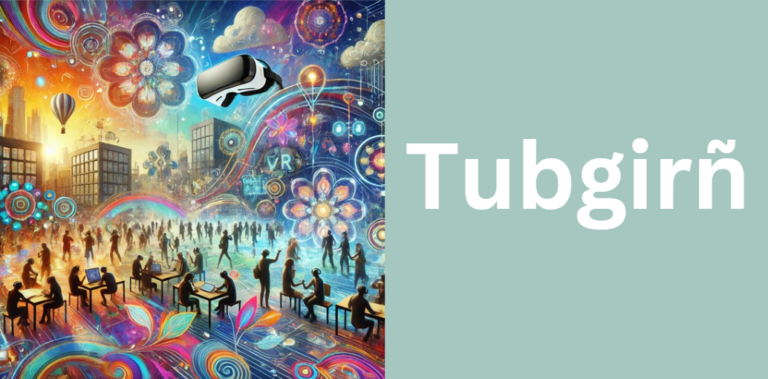
In the world of children’s television, few shows have had the impact of Wild Kratts. The show is not just about exploring animals and their habitats; it also imparts valuable life lessons.
One such lesson is the Gabby-Free Zone concept, a technique used to promote behavior improvement in a fun and engaging way. The Gabby-Free Zone behavior improvement Wild Kratts offers a fascinating glimpse into how structured environments can help children manage their behavior, focus, and social interactions.
What is the Gabby-Free Zone?

The Gabby-Free Zone behavior improvement Wild Kratts refers to a space where a character, Gabby, is temporarily excluded due to her disruptive behavior. Gabby’s enthusiasm and talkativeness often lead to distractions.
To manage this, the show introduces the Gabby-Free Zone, where she is given time away from the group to reflect on her actions and improve her behavior. This approach isn’t about punishing Gabby but rather creating an environment that helps her refocus and develop better social behaviors.
Purpose of the Gabby-Free Zone
The Gabby-Free Zone is a tool for promoting self-awareness and helping Gabby improve her focus. It provides both Gabby and the other characters an opportunity to engage in their tasks without distraction.
Key Characteristics of the Gabby-Free Zone
- Temporary exclusion for behavior correction
- Focused on positive behavioral change
- Non-punitive, offering reflection time
Why Was the Gabby-Free Zone Introduced in Wild Kratts?

The introduction of the Gabby-Free Zone behavior improvement Wild Kratts wasn’t accidental. Gabby, as a character, represents a common challenge for young children—difficulty managing their impulses and staying focused.
Her actions often serve as a reflection of behaviors many children experience, such as talking too much or being too distracted. The Gabby-Free Zone serves as a constructive way to show how a character can reflect on and improve their actions.
Reflecting Real-Life Behavioral Challenges
Gabby’s character in Wild Kratts mirrors common challenges children face, such as impulsivity and distractions. The Gabby-Free Zone gives young viewers an example of how to deal with such behavior.
The Goal of the Gabby-Free Zone
The goal isn’t to isolate or punish Gabby but to help her improve her behavior so she can be more focused and cooperative when rejoining the group.
How Does the Gabby-Free Zone Promote Behavior Improvement?

The Gabby-Free Zone behavior improvement Wild Kratts promotes positive behavior by providing children with a model for managing emotions and distractions. By giving Gabby time away from the group, the show teaches children that it’s okay to take a break and reflect.
The key is that this break isn’t a punishment; it’s an opportunity for Gabby to improve her behavior, so she can rejoin the group and contribute more effectively.
Teaching Emotional Regulation and Self-Reflection
The Gabby-Free Zone encourages children to practice emotional regulation. By showing that it’s okay to step back from a situation to regroup, the show teaches the importance of self-control and reflection.
Promoting Focus and Teamwork
The Gabby-Free Zone helps both Gabby and the other characters focus better on their tasks. This reflects the importance of maintaining concentration and cooperating with others in group activities.
The Psychological Value of the Gabby-Free Zone

The concept of the Gabby-Free Zone behavior improvement Wild Kratts is rooted in psychological principles related to behavior modification.
In child psychology, it’s essential to provide children with clear consequences for their actions. The Gabby-Free Zone acts as a non-confrontational space where Gabby can reflect on her actions, helping children understand how their behavior can affect others.
Self-Regulation Through Structured Time-Outs
The Gabby-Free Zone helps children understand the need for structured time-outs that promote reflection. These moments are essential for self-regulation, enabling children to return to a group setting with better emotional control.
Building Emotional Intelligence
By demonstrating how Gabby learns from her experience in the Gabby-Free Zone, children gain insight into developing their own emotional intelligence and understanding the impact of their actions on others.
Real-Life Applications of the Gabby-Free Zone

While the Gabby-Free Zone behavior improvement Wild Kratts is a fictional tool, its principles can be applied in real life.
Parents and educators can create similar environments in which children can take a moment to reflect on their behavior and return to their tasks or social interactions when they are ready. This is particularly useful in managing disruptive behavior or impulsive actions in both school and home settings.
Implementing a Gabby-Free Zone at Home and School
Parents and educators can create spaces similar to the Gabby-Free Zone to encourage children to reflect on their behavior. This structured space can help them manage their emotions and rejoin group activities in a more focused manner.
Using Time-Outs for Reflection and Behavior Correction
A Gabby-Free Zone is essentially a time-out space that helps children develop emotional self-regulation. When used effectively, it teaches children the importance of pausing and reassessing their behavior before re-engaging.
The Benefits of the Gabby-Free Zone for Child Development

The Gabby-Free Zone behavior improvement Wild Kratts offers several benefits for child development. One of the main advantages is the promotion of emotional regulation.
When children learn to recognize when they need a break and how to control their emotions, they are better equipped to handle social situations and interactions. This also helps them develop empathy, as they understand how their behavior affects others.
Emotional Regulation and Focus
The Gabby-Free Zone teaches children how to manage their emotions and stay focused. By demonstrating this through Gabby’s experiences, the show encourages viewers to practice self-control and emotional regulation.
Teamwork and Social Skills Development
By emphasizing the importance of cooperation and focus, the Gabby-Free Zone fosters teamwork and helps children develop positive social behaviors.
Criticisms and Controversies Around the Gabby-Free Zone Concept

While the Gabby-Free Zone behavior improvement Wild Kratts has been widely praised, some criticisms exist. Some parents and educators worry that using exclusion as a behavior management strategy could lead to feelings of isolation or rejection. It’s essential to ensure that the concept is framed as an opportunity for growth, rather than as a punitive measure.
Ensuring Positive Reinforcement
It’s crucial that the Gabby-Free Zone is not seen as punishment. Parents and educators should focus on positive reinforcement to help children understand that the break is for self-improvement.
Managing Emotional Reactions to Exclusion
If not used carefully, a Gabby-Free Zone could lead to emotional distress for children. To prevent this, it’s important to explain the purpose of the zone and its role in fostering better behavior.
FAQs
What Other Shows Use Similar Behavior Improvement Techniques?
Other children’s programs, such as Sesame Street and Dora the Explorer, incorporate lessons on self-regulation, teamwork, and emotional intelligence. These shows use various methods, like structured breaks or reflective moments, to teach positive behavior.
Can a Gabby-Free Zone Be Used for Children with Special Needs?
Yes, the Gabby-Free Zone behavior improvement Wild Kratts can be adapted for children with special needs. Modifying the space to cater to a child’s unique requirements can help them process their emotions and rejoin the group when they are ready.
How Long Should a Child Stay in a Gabby-Free Zone?
The length of time a child spends in a Gabby-Free Zone should be brief, allowing them to reflect on their behavior without feeling punished. The key is to ensure the child can come back to the group with a positive attitude and better behavior.
Are There Any Alternatives to the Gabby-Free Zone?
Yes, alternatives to the Gabby-Free Zone behavior improvement Wild Kratts include visual aids, calming activities like breathing exercises, or offering positive reinforcement when a child demonstrates improved behavior.
Conclusion
The Gabby-Free Zone behavior improvement Wild Kratts is more than just a creative plot device—it’s an educational tool that offers valuable lessons for young children. By promoting self-regulation, emotional intelligence, and teamwork, the Gabby-Free Zone encourages positive behavior change and provides children with the tools they need to manage their emotions effectively.
Whether in the world of Wild Kratts or in real life, creating a space for reflection and improvement is a key step in fostering personal growth and better social interactions. Through this powerful concept, Wild Kratts shows how the Gabby-Free Zone behavior improvement Wild Kratts can lead to lasting positive change for children.
Affiliated Posts Like Gabby-Free Zone Behavior Improvement Wild Kratts
eCrypto1.com Privacy Coins: Unlocking Confidential Cryptocurrency Transactions





